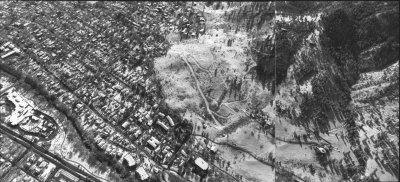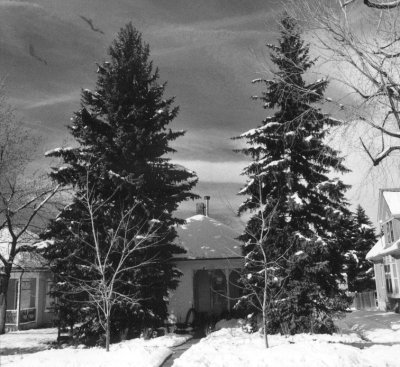We have a very nice, very small house and bit of land, 60 feet by
100' (1/7th acre), which lies at the foot of
Flagstaff Mountain in Boulder Colorado at 483 Marine Street. A part
of the old Highland Lawn neighborhood, it is surrounded by similar yards
and houses. A bit to the front sits the small, square one-story white
brick house with a pointy roof, 850 sq ft, including the porch. Built
as a development at the beginning of this century, along with two identical
houses to the west, it has high ceilings and quaint woodwork and plumbing.
An ungainly but useful basement lies below, functioning now as a darkroom
and biology lab.

It is a 'suburban bungalow', of which it has been said "while of slight
historical interest, they do exhibit a modest and unaffected charm,
as well as considerable ingenuity in combining many and varied rooms
in small, convenient layouts. Despite the constraints of budget, their
makers managed to bestow on these little homes all the requisite attributes
of domesticity--inviting trellised porches, intimate bay windows, dining
alcoves, and cozy fireplaces." (Witold Rybczynski, famous architect.
I had to add the fireplace myself, in the form of a woodstove, shortly
after we arrived in 1983.) Two huge blue spruce trees stand in front
of our bungalow, and a big apple tree shades the pocket-size back yard,
which is enclosed by a white picket fence. There's a little white shed,
10' by 16', fitted out as a study and retreat in which we seek refuge
from civilization.

This is a quiet neighborhood, a bit of a backwater frequented mainly
by those who reside here, unremarkable families like our own. I live
here myself of course, with my wife, Roz, one boy, Robin, sometimes
another, Jethro, a dog (now deceased), cat, a few trees and a lawn.
We feed wild birds in the backyard, and keep some scraggly flower beds,
but I had always thought of this as a relatively uninteresting habitat.
It is charming to be sure, but it lacks, or so I thought, great diversity
of flora and fauna. I was therefore quite surprised to discover, on
counting up, that there are at least 300 different species
on the property, readily distinguished without my touching a single
book, or going looking for any new specimens. If I got to know the bugs
better, or the protozoa or the weeds, the number of species would soar--and
think of the bacteria and viruses waiting to be known and counted!
I thought this over, and concluded that this little yard couldn't
be so interesting all by itself. It must draw its richness from complex
and non-obvious relationships with the whole ecosystem it is embedded
in, neighborhood, city, plains and mountains. I have long been interested
in the pretty parts of nature, the birds and clouds, mountains and flowers,
as many are, but was surprised to realize how little I knew about the
real ecosystem. What does a working neighborhood ecodeme actually look
like today--what's really in it? Where did it come from? What
holds it together and keeps it going? Such questions are not answered
to my satisfaction by the natural history books on this area, so I decided
to look into these matters myself. I followed these hidden lines of
force out from our yard--I wanted to discover the skeleton and sinews
of our bioregion, to get to know its many faces, public and private,
its hilly brows, arboreal hair and windy voice, its fertile farming
belly, its riverine loins, its residential fat and industrial guts.
First I made a close inspection of our yard itself. Then I explored
the trails leading directly out of it into the greater environment,
following them until they grew too vague to see clearly, i.e. until
I felt lost. The basic guideline in thinking about these things, as
it is when I wander about the landscape, was that I should have some
sense of where the house lies from here, and should be able to get home
by dark. I soon discovered that I was working in the tradition of Gilbert
White, the great 18th century English naturalist, whose book, A
Natural History of Selborne, is the original bioregional portrait.
Excellent reading too.
So this is a brief natural history of this house and yard, of those
who live here and those who visit, and of the four elements which flow
through it, where they come from and where they go.
Note: This is a work in progress and additional
materials will be put online as they are made ready.

